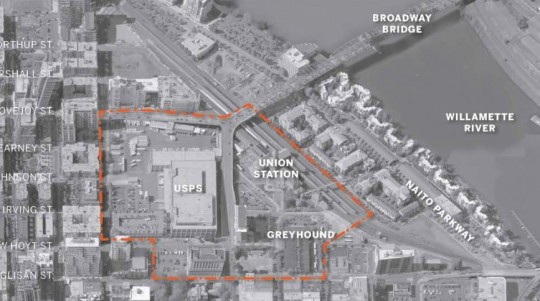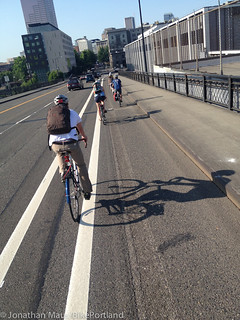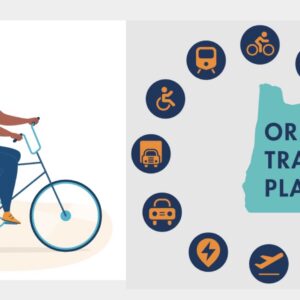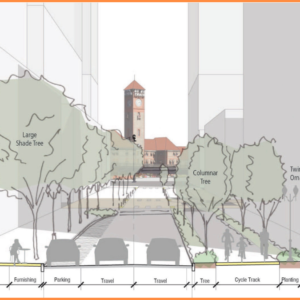By the end of this year Portland City Council will adopt a redevelopment plan that will have a huge impact on the central city — and it’s your job to make sure that plan includes a world-class vision for cycling.
As we first reported back in April, the Portland Development Commission wants to redevelop a 24-acre parcel of land bound by Union Station, the Broadway Bridge, NW 9th Avenue, and NW Glisan. NW Broadway — a major bicycle route into downtown — bisects the parcel. Beyond that, the future Green Loop that city leaders and planners say will create “Sunday Parkways everyday” will also run right through this parcel.
Suffice it to say, this is a golden opportunity to get biking right. But it won’t happen unless the PDC hears from smart people like you. Earlier this week the PDC opened up an “online town hall” to receive official comments on their Broadway Corridor Plan.
Here’s more about the plan from the PDC:
The Broadway Corridor Framework Plan will provide a comprehensive vision for this 24-acre portion of the Central City. While this area has long been envisioned as a potential regional asset, growth in the corridor has, until recently, been modest. Now, thanks to ongoing development in the neighborhoods surrounding the Plan study area, as well as the potential partnership with the United States Postal Service, the timing has never been better to identify how, when and what growth could occur here.
Advertisement
Creating the right mix of uses, activities, programs and public spaces for this area is, obviously, the challenge. Opportunities to reshape 24 acres of central city real estate don’t come along very often – and that’s where you come in. Your guidance and feedback as the process moves forward will shape this area’s development as a vibrant regional attraction for residents from throughout the city.
As this and other nearby areas continue to grow, we’ll have to fit more people onto our streets. The best, most efficient way to do that is to make sure as many people as possible can choose to use a bicycle to get around.
The PDC is accepting comments via an online survey that will be open through July 19th. Two days later (on July 21st) they’ll have the second of three open houses for this project and they expect to have a final plan endorsed by City Council by October of this year.
We know from past experience that these lofty plans talk a big game when it comes to cycling, but they have tendency to make it only a minor consideration after auto access, bus and rail transit, business interests, and so on. Let’s not make that mistake again.
Learn more and leave your feedback here.







Thanks for reading.
BikePortland has served this community with independent community journalism since 2005. We rely on subscriptions from readers like you to survive. Your financial support is vital in keeping this valuable resource alive and well.
Please subscribe today to strengthen and expand our work.
We must also be pushing for high capacity, 24-7 transit like a subway or skytrain. People should include this in their testimony. If we don’t focus on a variety of alternate modes, we will fail. Right now, MAX isn’t on par with the subway in NYC or skytrain in Vancouver. We need rapid 24-7 service. We can do this by taking money away from cars and putting that in the pot for all other modes. Bike and transit are severely proportionally under-served by our budget! This project must also eliminate height restrictions to promote as much density as possible. Incentives for inclusive buildings is a mus, too. If this has no low income housing mixed in in the same buildings as office and retail and other income housing, this will be an example of poor community design.
There’s room in the survey for all these ideas! I hope you’ll take the time to share them with PDC, if you haven’t already done it.
I don’t think Portland has the population density for high capacity transit running around the clock. Many subways don’t run much past midnight in many cities, save for NYC and other larger ones. Of the 15 or so systems I’ve ridden I think only NY Subway runs all night, but limited. Most European cities cut the metro off sometime just after midnight but trams and busses run less frequent night schedules. Prague night trams run at 30 minute intervals for example.
It would be nice if the Max red line from the airport was still running after the last flights of the night get in. Sheesh.
Give the area 30ft wide roads closed to cars. That’d be spectacular.
Jonathan and Michael: I’m about to head over to the survey and do my best, but first, a peripheral question. What IS PDC?
It seems like a dumb question, I know. Portland Development Commission, the clue being in the middle name, etc. But once, when I had to define some financial record-keeping relationships among various agencies connected to the City of Portland, no amount of research revealed what exactly the relationship is between PDC, the City, Portland taxpayers, and the private sector. It was like a black hole.
So, from your highly-attuned perspective, what is it? Why is it so powerful? How much does it have to pay attention to what citizens say they want? Etc.
Just curious.
Okay, giant initial eye-roll:
The Framework Plan will provide a strategic vision for the broader study area and development concepts for the USPS site. Five goals or guiding principles will shape the strategic vision for redevelopment within the study area. Together, the consultant team, stakeholder advisory team and technical advisory team are exploring the following five draft goals and discussing examples of their implementation.
I’ve got at least five squares marked off on my Bureaucratic BS Bingo card already. I think this opening paragraph of the survey translates to:
We’re going to develop the USPS site. We’ve already gathered professionals, experts and people with [undisclosed] interest in the project, and they’ve already chosen five project goals. Now we’re looking at how those goals might work out. It’s your turn, O public citizen, to weigh in.
WARNING: You’ll complete the survey before signing in/on and choosing whether to use your name in the posted results. If you should for some reason use your browser’s back button at this point, all your carefully-thought-out narrative answers will disappear.
Ask me how I know.
NVM. I muddled through the interface and recovered my brilliance.
We want public input, but ask you to answer questions that don’t really ask anything. Typical.
The categories are vague enough that you can shoehorn pretty much any comment into at least one of the categories. Anything related to cycling can very easily be left under the “connected” category.
It really is a frustrating combination of vague and predetermined. But I give them credit for the wide-open text fields, where I left them many words and called them on their vagueness.
I left my typical comment of “install more separated bike facilities”. This is a golden opportunity for the city to show they are serious about cycling and also for them to improve bike access to the Broadway Bridge. The three-way intersection and streetcar tracks make it tricky to navigate on bike.
The 2010’s: reteaching Portland the things Portland taught us about good bike infrastructure.
A couple of things strike me as I read through the responses so far. First, there’s a gratifying amount of “more, better bike facilities” and “don’t encourage cars”. So that’s good.
But there’s a hidden thing, too, and it’s at the heart of my initial reaction to the bureaucrat-ese in the first paragraph: The whole survey is written to exclude people who:
* aren’t well-educated
* aren’t already comfortable with the language of public policy
* aren’t fluent in English
* can’t imagine how development in the central city might affect them
And it’s coded so that bald statements about profit, taxation, funding, and returns on investment are not actually mentioned.
There are so many unexamined underlying assumptions! I imagine that the whole thing is well-intended, but they clearly didn’t go outside their in-group of consultants, technicians and “stakeholders” for help in composing this survey.
Please remind designers and decision-makers that you would like to get from A to B by bicycle in a reasonably direct manner while safely and comfortably doing it at up to 20mph. Also, the designers and decision-makers should ride a bike on it at least once (I’m looking at you Broadway, SW Multnomah, Moody (Bond?), the weird stuff at both ends of the Tilikum Crossing.) Do we have a good example of a bikeway anywhere in town yet? (I haven’t ridden any of the N/NE projects.)
I’d say SW Moody is pretty close to an ideal bikeway. Only change I’d have made is move the cycle track in between the sidewalk and road.
Crossing the streams at a blind corner is a problem, the jug-handle crosswalk, the Bond detour, and generally sharing a big sidewalk with just some labels can be problematic when people are walking on it. The driveway crossing might also leave you liable if you’re hit having entered it at more than a walking pace (is it a bike lane or a sidewalk?) This last bit of Oregon law is something we should perhaps fix and definitely account for in our designs (take a ride eastbound on SW Multnomah.)
a few more:
*the very large bridge column that obscures sight lines as cyclists enter bike facility from the south.
What sorts of things are on the table for a redevelopment like this? Are they leveling the site? Replatting? Is Union Station safe?
Only an assumption, but I suspect that most if not all of it will be leveled and completely redeveloped. Seismic upgrades alone could easily cost as much, if not more – than starting from scratch.
I assume you’re talking about the post office. Union Station isn’t going anywhere.
Is there some unannounced “done deal” where the USPS has already agreed to vacate the site, or is everyone assuming that will happen? I thought USPS wanted PDC to buy them a new location, preferably near the airport. That won’t be cheap, based on the size of the site that they’re going to want.
Does this 24 acre plan also include building housing for the homeless? Adding places like the Bud Clark Commons building is an essential step.
I have lived in Portland for over 30 years (with stops along the way also in Berkeley, Eugene and Davis during that time) but there are still so many people who sleep under bridges. Overtime I ride from my home in NW Portland, often along Waterfront Blvd, I meet them. It is difficult for me to get excited about more “development” in the form of expensive condos and shops where some customers wait in line 45+ minutes or more to buy a donut or an ice cream cone. I measure a city not by how many varieties of coffee one can consume but by how it treats those most vulnerable.
I meant “every time” and not “overtime.”
Are there any plans to fix up the area on the OTHER side of the river, where you get off the Broadway Bridge and head up towards Williams/ Vancouver? That was last time I checked out the most deadly to cyclists area of the city, where cyclists, automobiles, I5 bound and otherwise, plus Tri Met trains all come into conflict. Sketchy area, that.